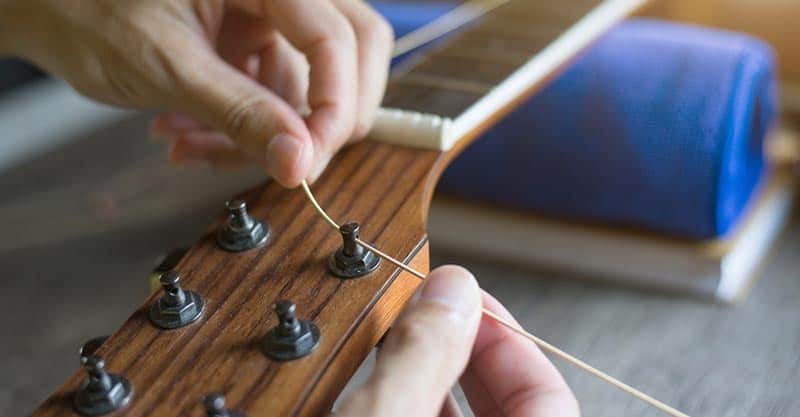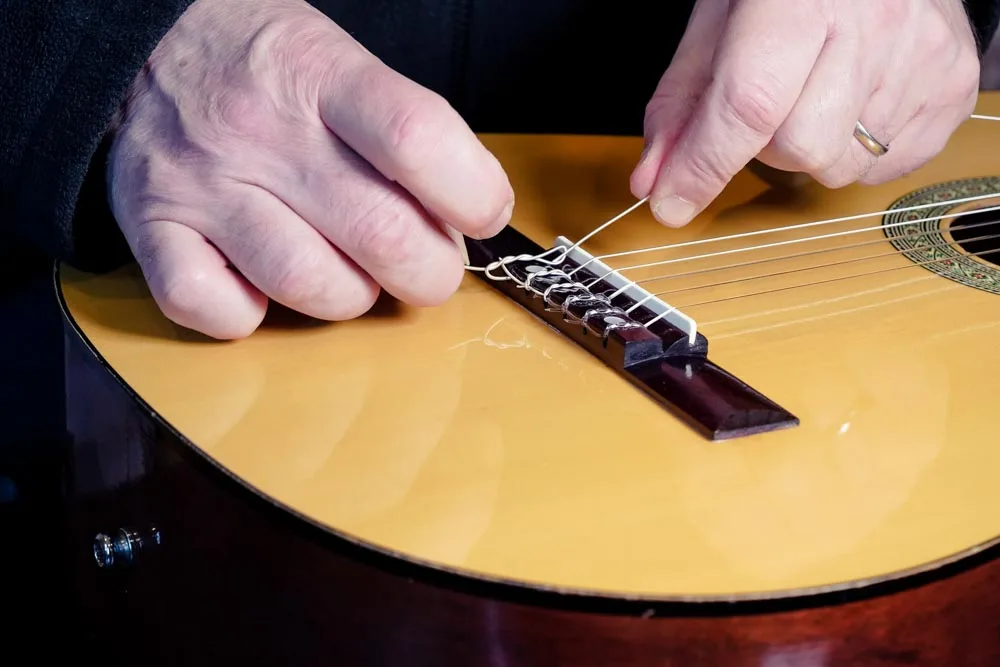Are you a beginner guitarist wondering how much it costs to restring your guitar? As a fellow music enthusiast, I know the struggle of trying to figure out all the necessary expenses for pursuing this passion. But don’t worry, I’ve got you covered! In this article, we’ll dive into everything you need to know about restringing your guitar – from the cost and equipment needed to tips and tricks for beginners. By the end of this guide, you’ll have all the information you need to keep your guitar sounding great without breaking the bank. So let’s tune in and learn about how much it really costs to restring a guitar!
So, how much to restring a guitar?
Restringing a guitar is an essential skill for any guitarist, whether you’re just starting out or have been playing for years. It’s important to know how much it will cost to restring your guitar so that you can budget accordingly and keep your instrument in top shape.
The cost of restringing a guitar can vary depending on several factors such as the type of strings used, the location where you get them restrung, and if there are any additional services included. On average, it can range from $20-$50.
If you’re a beginner and not sure how often you should restring your guitar, it’s recommended to do so every 3-6 months. This may seem like a lot but regular string changes help maintain the tone and playability of your instrument.
When getting your guitar restrung by an expert, they will not only change the strings but also clean and condition the fretboard, adjust the truss rod (if needed), polish the frets, and tune up the entire instrument. These extra services may add to the overall cost but are crucial in keeping your guitar in good condition.
It’s also worth noting that different types of guitars require different types of strings which can affect their price. For example, acoustic guitars typically use steel strings while electric guitars use nickel or stainless steel strings. Classical guitars use nylon strings which tend to be more affordable compared to other types.
In addition to knowing how much it costs to restring a guitar, it’s important for beginners to learn how to do it themselves as well. Not only does this save money in the long run but also allows for more frequent string changes without breaking the bank.
Overall, knowing how much it costs to restring a guitar is important information for any musician looking to keep their instrument in top shape. Whether you choose to have an expert do it or learn how yourself, regular string changes are necessary for optimal sound quality and playability. Happy strumming!
Understanding the Process of Restringing a Guitar
Restringing a guitar may seem like a daunting task for beginners, but once you break it down, it becomes an enjoyable ritual. First, gather your materials: new strings tailored to your guitar type, wire cutters, and possibly a string winder to speed things up. Start by loosening the old strings with your tuning pegs; it’s often easier than trying to cut them off first. Once they’re loose enough, remove them from the bridge and pull them out of the tuners on the headstock. As you do this, take a moment to note how each string is threaded through its respective tuner; this will save you some time when putting on the new ones.
Once everything is cleaned up and ready for fresh strings, grab your new set! Begin inserting one end of each string into its designated hole at the bridge before feeding it through the corresponding tuner peg at the top. Make sure that they are wound neatly around their posts—this helps maintain stability and tuning accuracy over time. After all six strings are in place and tightened to pitch, allow yourself some time for adjustments while strumming gently on open chords. This entire process not only enhances playability but also deepens your connection with an instrument that carries music’s rich history within its frame.
Read also: used yamaha guitar
Cost Factors Affecting the Restringing of a Guitar
When it comes to restringing a guitar, several cost factors come into play that can influence how much you’ll end up spending. Strings themselves are the most obvious expense. They vary widely in price depending on the brand and material used—steel strings might be cheaper than nylon or coated varieties, which resist corrosion and last longer. You may also want to consider whether you’re using standard or custom gauges, as lighter or heavier strings can affect both sound quality and playability.
Additionally, another factor to think about is the labor costs. If you decide to do it yourself, you’ll save money but need some tools like wire cutters and a tuner at hand. On the other hand, taking your guitar to a shop means paying for professional labor—a fair trade-off if you’re unsure of your skills! Other costs could include maintenance items such as lubricants for tuning pegs or fretboard conditioner. Each element contributes not just to how much it will cost today but also impacts your instrument’s longevity and performance over time.
In conclusion, while restringing a guitar might seem straightforward, it’s wise to examine all associated expenses carefully for an optimal playing experience.

Types of Strings and Their Impact on Guitar Restringing Cost
When it comes to guitar strings, the variety available can seem overwhelming. Each type of string has its unique characteristics that can significantly influence both sound and cost. For instance, nylon strings, often used on classical guitars, provide a warm and mellow tone but tend to be less expensive than their steel counterparts. In contrast, steel strings, popular among acoustic and electric guitar players for their bright and cutting tonal quality, come in different gauges (thicknesses) that affect not only playability but also price. Heavy gauge strings might offer a richer sound but could demand more from the fingers during playing.
The impact on restringing costs largely hinges on these types of strings as well. Guitarists who prefer premium materials like coated or alloyed options may find themselves paying more upfront but enjoy longer-lasting performance with less frequent changes—an important consideration for musicians who perform regularly. Notably, brands also vary widely; some budget-friendly manufacturers produce decent-quality strings while renowned brands can charge a premium due to reputation or innovative design features. Ultimately, understanding these types allows guitarists to choose wisely based on their style and financial considerations while ensuring their instrument sounds its very best!
DIY vs Professional Services: Weighing Costs and Benefits for Restringing Your Guitar
When it comes to restringing your guitar, the choice between DIY methods and hiring professional services can be a bit tricky. On one hand, doing it yourself can feel rewarding and save you some cash. You just need a few basic tools like string cutters, wire snips, and a tuner. Plus, each time you change strings on your own, you’re building skills that deepen your connection with the instrument. However, if you’re not careful or don’t know what you’re doing, you might end up with improperly installed strings that affect sound quality or even damage your guitar.
On the flip side, professional services offer expertise that’s hard to match. Experienced technicians understand how different strings can influence tone and playability; they also have access to high-quality materials that ensure optimal performance. While this option typically costs more than going solo—often ranging from $20 to $50 depending on where you go—the benefits include peace of mind knowing that everything has been done right.
Here are some factors to consider:
- Time: DIY may take longer as you hone your skills.
- Experience: Professionals quickly get things done correctly.
- Cultural connection: Restringing yourself fosters a personal bond with the guitar.
Ultimately, weighing these options depends on how much value you place on learning versus convenience!
You may also like: What is the history of the Yamaha APX Guitar Series
Effective Tips to Reduce the Frequency and Cost of Changing Guitar Strings
Changing guitar strings can be a hassle, especially when it seems like you’re doing it all the time. To extend the life of your strings and save some money, consider these simple yet effective tips. First, always wash your hands before playing. Natural oils from your fingers can corrode the strings faster; clean hands mean cleaner strings! After each session, gently wipe down the strings with a soft cloth to remove sweat and grime that can build up over time. This quick routine keeps them shining bright and helps maintain their tone for longer periods.
Another way to cut costs is by choosing high-quality strings suited for your style of playing. While they might cost a bit more upfront, premium options often last much longer than cheaper alternatives. Additionally, store your guitar in its case when not in use; this protects it from dust and changes in humidity that could affect string integrity. You might also want to experiment with different tunings or gauges—sometimes a lighter string can feel just as good but may resist wear better under certain conditions.
By adopting these habits, you’ll not only enjoy smoother sounds but will also find yourself changing those strings less frequently while keeping expenses down!
Conclusion: Keeping your guitar well-strung without straining your budget.
Taking care of your guitar strings is a key part of playing music that sounds beautiful. When you replace your strings regularly, it keeps the sound fresh and vibrant. However, guitar strings can sometimes feel like they’re eating up your budget if you play often! Fortunately, there are some simple ways to keep your instrument well-strung without breaking the bank. First off, consider buying in bulk. Many music stores offer discounts when you purchase multiple sets at once. This not only saves money but also ensures you’re always ready to change strings whenever needed.
Another great tip is to learn how to properly maintain and clean your current strings. Wiping them down with a soft cloth after each use helps remove sweat and dirt that can cause wear over time. You might also explore string lubricants, which can extend their life by reducing friction during play. Additionally, experimenting with different brands or types might uncover budget-friendly options that still deliver excellent sound quality.
By being mindful of these practices, you’ll enjoy rich melodies from your guitar while keeping an eye on expenses—allowing you to focus on creating music instead of worrying about costs!

